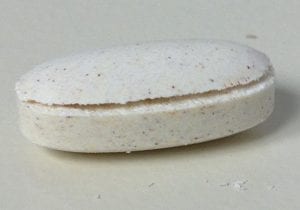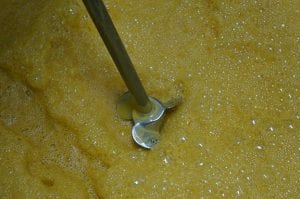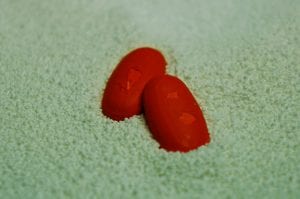High-quality coating begins with high-quality tablets, and no coating can achieve peak adherence unless all the tablets in a batch are uniform. When the substrate is prepared properly, tablet coating quality is predictable. A film coating won’t hide tablet quality problems and will, in fact, likely magnify quality variations, even when they aren’t extreme. This article discusses how variations in tablets—even when in the acceptable range—can affect film coating.
Tablet coating, it’s been said, is more art than science. In some cases, that might be true, but it’s still worth knowing certain facts—science if you will—about this challenging and dynamic process if you want to succeed more regularly. Knowing the facts makes it a science. Not knowing them and trying to solve problems makes it an art.
There are many coating types and application methods. This article focuses on the most common method, film coating, where a mist of solution (suspension) coalesces and adheres as a thin film on the surface of tablets. When done right, it’s a very predictable and reliable scientific process.
Why coat?
Film coatings offer several benefits. A primary one is protection against erosion, chipping, and breakage. With a film coating, tablets are stronger and tougher, so they can withstand the routine buffeting of transport and packaging, Coatings also extend shelf-life, mask bitter tastes and off-putting odors, and add flavor and color.
Functional coatings go even further. They can deliver active ingredients to accelerate the therapeutic effect, control the release of the active ingredient, and provide a barrier against moisture. Functional coatings that are pH-dependent, known as enteric coatings, allow tablets to pass through the highly acidic environment of the stomach unaltered and then disintegrate in the near-neutral intestines.

Different surface, different hardness
To minimize the art and maximize the science of film coating, reduce the variables. One of the biggest variables is tablet hardness, specifically the surface hardness. No batch of tablets is more difficult to coat than the one with a wide range of hardnesses, because the coating will not interact with each tablet the same way.
Even when all the tablets are within the specified “acceptable range,” some will have a softer surface that erodes more easily. The tablets with harder surfaces may not allow the coating to adhere as well, which could lead to defects such as peeling. Identifying the variation in tablet surface hardness is difficult, however, because there is no instrument to measure it. (Traditional hardness testers actually quantify breaking strength, which tells us little to nothing about surface hardness.) In fact, we should say surface hardnesses, because the hardness of the top, bottom, and sides of a single tablet differ.
We know tablet surface hardnesses are different because of how tablets are compressed and ejected. When a tablet is formed, the top is softer because air pushed upward gets trapped within the upper cup of the tooling; fines migrate to the vent area (gap) between the die wall and the upper punch tip. Because of the hardness differences, a coating may not adhere equally to all areas.

Understand the substrate
As discussed above, the top cap of a tablet is often softer than the lower cap because of how it’s made. In addition, because the top bears a logo or other debossing, it’s more prone to erosion than the tablet’s bottom cap.
As for the side (side band) of the tablet, the larger it is, the greater the friction and heat when the tablet is ejected from the die. To minimize friction, most tablets include lubricants, also known as mold-release agents. The lubricant creates a glossy surface on the tablet and it tends to get glossier as tablet hardness increases. Hard, glossy surfaces are not ideal for film coating. Incidentally, the larger the side band, the more difficult it is to apply an even coating all the way around the tablet.
The tablet edges, formed by the land area of the punch tip, also warrant comment. They don’t accept coatings as well as other areas. In fact, after finishing a batch, it’s common to find tablets that aren’t coated along the edge. Plus, that’s where the granulation can extrude into the gap between the punch tips and die wall. Known as flash, wing, or crown, this excess material varies in size and shape according to the condition of the punches and dies, how they’ve been installed, the clearances, and their wear properties. To prevent the flash from causing defects, remove it using a deduster or during the preheat cycle before spraying begins.
The tablet’s constituents also affect the coating. Ideally, when a coating suspension is sprayed on tablets, the carrier (usually water, but sometimes a solvent) dries rapidly, leaving the solid portion to lock together into a “shell.” But if some portion of the tablet’s surface resists coating impingement, variability increases. In terms of absorption properties, some ingredients are like cotton t-shirts and others like raincoats. Because particles of each type can reach the surface, the coating attaches to some particles but forms bridges over others. By and large, these little bridges hold up well, but when they don’t, it’s often because the particle is too large. Check-screening the granulation before it reaches the press will help prevent the problem, which usually shows up as a white spot on the coated tablet.
Magnesium stearate—the most common tablet lubricant for tablets—is the most likely to cause this defect because it’s not water-soluble like most other ingredients. If a lump of magnesium stearate is compressed on the surface of the tablet, the coating defect looks like a pimple. Again, proper screening can reduce the number of these defects.
The amount of coating applied to tablets is measured in percentage weight gain, which typically ranges between 1 and 3 percent. Clear protective coatings skew toward the lower end of that range, while functional coatings and color coatings are on the upper end. The coating suspension itself is usually about 15 percent solids, but can range as high as 35 percent. Most coatings are prepared by combining a ready-to-mix powder formulation and water, which creates a suspension. The suspension must be well mixed and free of lumps and foam so that it sprays uniformly. It’s the polymers in the coating that bridge over any absorption-resistant particles on the tablet surface, while plasticizers enable the coating to withstand expansion and contraction to prevent cracking. Ultimately, successful coating depends on the strength of the tablet and how well its particles and the coating lock onto one another. Any soft or friable tablet particles will result in defects and possibly a batch failure. In fact, poor tablet surfaces are a leading cause of failures.
Time to coat
Most tablets are coated in batches but the number of continuous coaters is growing. Actually, most of these systems operate semi-continuously, coating batch after batch without stopping. I have yet to see a manufacturing operation in which tablets flow directly from the press to the coater, and there’s a good reason for that: Tablets are hot when they leave the press from the friction of compression and ejection.

(Typically, the faster the press, the hotter the tablet.) Also, depending on the ingredients, tablets usually gain hardness over the first 24 to 48 hours. If you were to coat the tablets before they cooled and hardened, the coating would probably fail. In most cases—and there are exceptions—you get the best results if you let the tablets rest 24 hours before you coat them.

For the best results, coatings must be applied in a controlled


environment, and the tablets must be heated—between 42° and 46°C usually—and dedusted before spraying begins by rotating them in the coating drum. Every coating systems has an air-handling unit to supply conditioned air and to extract dust and moisture. If the tablets and/or the coating environment are too cool, over-wetting can occur, which will soften the tablet surfaces and thereby promote erosion. When the environment is too hot, the coating dries too rapidly and doesn’t have time to adhere to the tablet surface.
The construction of coating pans, also called drums, has changed significantly over the years to control drying rates. Spray guns have also been upgraded to prevent “beards” from forming on the nozzle. In practice, the guns spray a mist in the direction of the airflow so it’s pulled toward and through the tablet bed. The objective is to expose the tablets to frequent and light misting so the coating dries quickly but not too quickly. Gun-to-bed distance is also important. Too close and the tablets will be overly wet; too far, and the coating dries before it contacts the tablets. The drum’s speed, the rate of airflow, and the shape of the tablets also affect how the coating process performs.
Written by: Michael D. Tousey
